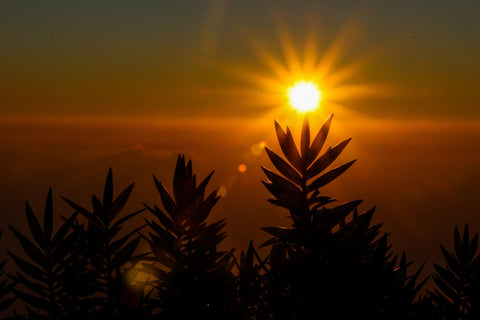Biohacks for natural light and darkness during the day
Light is a nutrient that regulates many metabolic pathways in the body. Short-wave blue light inhibits the secretion of melatonin. Darkness is the antagonist and the necessary signal for melatonin to be activated.
Image: A circadian clock in an imagined beautiful world undisturbed by toxic blue light.
Image license: NoNameGYassineMrabetTalk fixed by Addicted04, CC BY-SA 3.0 <https://creativecommons.org/licenses/by-sa/3.0>, via Wikimedia Commons
The last blog article on Stress and the Adrenal Glands discussed different types of stress in our modern lifestyle that affect cortisol and other hormone levels. Here is the continuation with more about how the wrong light during the day becomes an additional stress.
The signaling substance melatonin regulates sleep and wakefulness
Not so long ago it was discovered that there are light receptors not only in the eyes, but in many other cell types in the body.
- Did you know that your sleep and wakefulness are affected by all light that is not red or near-infrared when it reaches your eyes or your skin before sunrise or after sunset?
Outdoors as well as in our homes, we live under an extreme light environment that the light receptors in our cells have never before been exposed to during human development:
• In nature, blue or green light does not exist alone
• Our melatonin turnover pathways are just one of many biological processes encoded for light
• Energy production in the mitochondria is another. Inside the mitochondria's enzyme chain are receptors for red and near-infrared light. When red light is captured in these photon traps, we can produce more energy molecules.
Red + near infrared light releases nitric oxide into the blood
Which has many positive effects:
• the defense cells' ability to fight viruses increases
• increased circulation of blood and lymph → detox ability is increased
• reduces inflammation
• reduces pain
• increases wound healing
Practical tips for a biologically adapted lighting environment
Get more natural light during the day:
Melatonin begins to be created and prepared during the day during blue (and also green) wavelengths. The sun's different wavelengths of light trigger light receptors in our cells to produce hormones and energy.
Red light at sunrise and sunset has a special effect on our mitochondria, where all the body's energy is created.
• Go outside for a while at sunrise and sunset, in the middle of the day and in the afternoon. When the weather permits, expose as much of your skin to light as you can. Sunglasses ruin everything. Remember: your cells in the eyes and skin are damaged by a lack of melatonin.
At home, at work, in a blue light-toxic environment, i.e. in shops, public premises, hospitals, subways, trains and stations, schools, etc.:
• use glasses that filter out some of the harmful light during the day in front of screens. The day glasses look slightly yellow or completely discolored.
• preferably turn off screens a few hours before bedtime. Optimal amount of melatonin is not completed until our eyes/skin has been completely without blue (and green) light for two-three hours
• use settings or apps on your computer and phone so they don't give off blue and green after sunset. Here's how to fix a red screen on your iPhone
• use blue/green blocking glasses in the evening in front of screens unless you have a fully blue/green blocking app, or when you are in an unnatural light environment as above
• make sure to sleep really dark. Use blackout curtains. Block any streaks of street light that seep through on the sides. Wear a sleeping mask when you travel.
If you get up at night:
• do not light lamps with white/blue/green light. Use a candle or have special night lights that only glow red.
This is especially important for toddlers – and their parents! - which should train in a good circadian rhythm. Sitting with them on your lap in front of a blue emitting TV screen destroys their melatonin with all that means for immune defense and cell repair.
Protect your eyes from artificial wavelengths and light
An unnatural mixture of light colors destroys melatonin not only in the evening and at night. Natural light prepares melatonin during the day. Melatonin is one of our strongest natural protections against various forms of cancer and against DNA-damaging radiation.
In the next article, we will go through examples of different light therapy lamps and how you can use them to supplement your natural light.
Sources:
1. Do MTH. Melanopsin and the Intrinsically Photosensitive Retinal Ganglion Cells: Biophysics to Behavior. Neuron. 2019 Oct 23;104(2):205-226. doi: 10.1016/j.neuron.2019.07.016. PMID: 31647894; PMCID: PMC6944442.
2. https://www.smhi.se/kunskapsbanken/meteorologi/solstralning-1.4186
3. Münch, Mirjam et al. “The Role of Daylight for Humans: Gaps in Current Knowledge.” Clocks & sleep vol. 2.1 61-85. 28 Feb. 2020, doi:10.3390/clockssleep2010008
4. Awad-Alkoziv H. Melatonin and melanopsin in the eye: friends or foes?. ANALES RANF [Internet]. Real Academia Nacional de Farmacia; An Real Acad Farm · Año 2019 · volume 85 · numero 01:49-59.




